AMD RTG Summit: HDR, Displays, FreeSync, and More
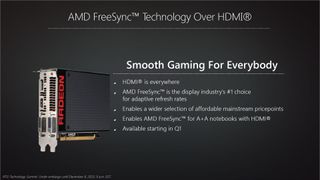
FreeSync Evolves to Support HDMI
Next up was a discussion of all things FreeSync, which encompasses several sub-topics. The big headliner is that FreeSync is using the HDMI vendor extensions to support variable refresh rates over HDMI going forward. Considering many inexpensive displays only support HDMI input, this sounds like a big win, but there’s a pretty massive catch: It isn’t possible to support FreeSync on older displays. That may seem obvious, but it means if you want FreeSync over HDMI, you’re going to need to buy a new display, and if you’re already buying a new display, you might consider spending more for a display that supports DisplayPort as well as HDMI. At least current FreeSync-enabled GPUs will be able to support HDMI FreeSync, so it’s a net win.
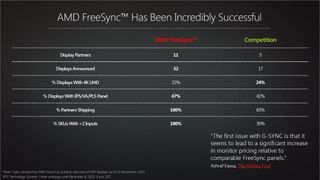
Other FreeSync news ends up being far more promising. From a market standpoint, we’re seeing a lot of FreeSync displays, and AMD is quick to point out that the FreeSync displays cost less and there are more of them compared to competing G-Sync offerings. That’s all true, and since FreeSync only uses standards that are already a part of the DisplayPort 1.2 spec, most new displays are able to support the technology. The problem is that Nvidia has a much larger market share for GPUs right now, and so far they have proven unwilling to support FreeSync, which means for the time being we’re at an impasse. Until we have a unified standard, consumers will ultimately lose out, but it could be years before that happens.
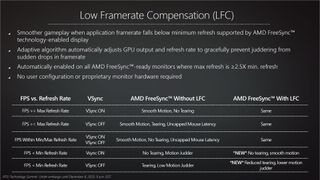
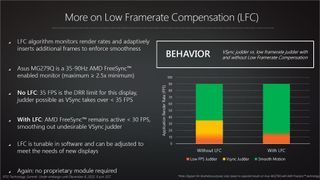
One of the big announcements for FreeSync last month came with the launch of Radeon Software Crimson Edition, which brought support for Low Framerate Compensation (LFC). This basically improves the algorithms on the GPU side to give a more fluid experience when you fall below the minimum supported refresh rate. This mostly brings FreeSync up to the level of G-Sync for lower framerates, which is good news. The bad news is that it’s only something that works with certain FreeSync monitors, specifically monitors where the maximum supported refresh rate is at least 2.5 times higher than the minimum supported refresh rate. So if you have a 40-144Hz FreeSync display, you’re golden; that 48-75Hz LG Ultrawide on the other hand gets left out in the cold, along with the 30-60Hz 4K panels.
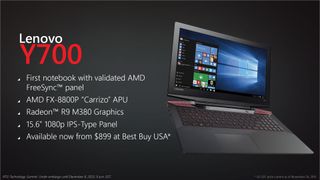
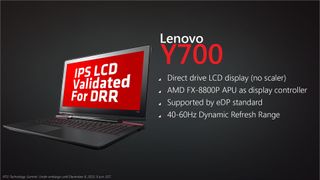
AMD also announced that the first FreeSync laptop is now shipping, in the form of the Lenovo Y700. This features an R9 M380 GPU with an AMD FX-8800P Carrizo APU, paired with a 15.6-inch 1080p IPS-type panel. (That might mean AHVA or PLS, but the net result is wider viewing angles than TN.) All of this sounds promising, but the actual supported refresh rates leave us scratching our heads: 40-60Hz. See above for the LFC discussion, and then you have to wonder why Lenovo didn’t opt for a more sensible 30-75Hz range. Pricing at least is decent, at $899 via Best Buy, with more FreeSync laptops slated to launch over the coming weeks.
The biggest gaming news, reviews and hardware deals
Keep up to date with the most important stories and the best deals, as picked by the PC Gamer team.
Jarred's love of computers dates back to the dark ages when his dad brought home a DOS 2.3 PC and he left his C-64 behind. He eventually built his first custom PC in 1990 with a 286 12MHz, only to discover it was already woefully outdated when Wing Commander was released a few months later. He holds a BS in Computer Science from Brigham Young University and has been working as a tech journalist since 2004, writing for AnandTech, Maximum PC, and PC Gamer. From the first S3 Virge '3D decelerators' to today's GPUs, Jarred keeps up with all the latest graphics trends and is the one to ask about game performance.
Most Popular


